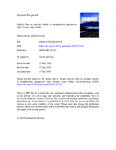Alluvial fans on volcanic islands: A morphometric perspective (São Vicente, Cape Verde)
| dc.contributor.author | Stokes, M | |
| dc.contributor.author | Gomes, A | |
| dc.date.accessioned | 2020-08-05T06:37:03Z | |
| dc.date.available | 2020-08-05T06:37:03Z | |
| dc.date.issued | 2020-11-01 | |
| dc.identifier.issn | 0169-555X | |
| dc.identifier.issn | 1872-695X | |
| dc.identifier.other | 107356 | |
| dc.identifier.uri | http://hdl.handle.net/10026.1/16132 | |
| dc.description | 24 months embargo. | |
| dc.description.abstract |
The distribution, morphology and development of volcanic island alluvial fans are investigated using São Vicente from the Cape Verde volcanic chain (east-central Atlantic Ocean). This is a tectonically and volcanically inactive dryland setting, comprising an eroded Plio-Pleistocene composite volcano overlying a submarine shield volcano. We mapped 228 alluvial fans, quantifying fan (F) and catchment (C) morphological properties (area [A], gradient [G], relief [R], length [L]). Fans and catchments of varying size and gradient are distributed around the island coastal margins (6%) and along interior valley sides (94%). Regression results (i.e. +ve/−ve slopes of best fit lines) conformed to broader fan research but with weak correlations, and coefficient-exponent values outside, or at the lower end of values reported from non-volcanic settings. Analysis of fan area and gradient vs catchment area regression residuals revealed fans were dominated by small-steep gradient (28%) and large-low gradient forms (39%). Fan building space is a fundamental control, specifically linked to volcano structure, but with interplay between rock strength, base level, and climate. Fans around the volcanic edifice flanks are uncommon due to steep flank slopes. Where flank margin fans occur they are typically small and steep forms due to marine erosion. Fans along flank incised valleys are common. Large low gradient fans are associated with a major volcanic rift-aligned valley structure, with extensive erosion into altered and weathered edifice-core lithologies. Small-steep gradient fans are associated with edifice flank valleys. Steeper and narrower valley forms reflect incision into stronger lithologies of the composite volcano flanks, restricting fan building space. Fans located within the volcano central depression are amongst the largest and lowest gradient types, building into the eroded and unconfined edifice core space. Coalescence, apex-toe incision, toe erosion and catchment stream channel backfilling displayed by most fans suggest landscape erosion dominates during more arid periods (e.g. interglacials), with the dryland setting generating limited sediment and insufficient flood runoff for transport and fan deposition. Fan building likely occurs during wetter periods linked to Quaternary climate variability. Quaternary eustatic variations are relevant for the volcano edifice margins where sea level changes control fan building space and erosion. | |
| dc.format.extent | 107356-107356 | |
| dc.language | en | |
| dc.language.iso | en | |
| dc.publisher | Elsevier BV | |
| dc.rights | Attribution-NonCommercial-NoDerivatives 4.0 International | |
| dc.rights | Attribution-NonCommercial-NoDerivatives 4.0 International | |
| dc.rights | Attribution-NonCommercial-NoDerivatives 4.0 International | |
| dc.rights | Attribution-NonCommercial-NoDerivatives 4.0 International | |
| dc.rights | Attribution-NonCommercial-NoDerivatives 4.0 International | |
| dc.rights.uri | http://creativecommons.org/licenses/by-nc-nd/4.0/ | |
| dc.rights.uri | http://creativecommons.org/licenses/by-nc-nd/4.0/ | |
| dc.rights.uri | http://creativecommons.org/licenses/by-nc-nd/4.0/ | |
| dc.rights.uri | http://creativecommons.org/licenses/by-nc-nd/4.0/ | |
| dc.rights.uri | http://creativecommons.org/licenses/by-nc-nd/4.0/ | |
| dc.subject | Alluvial fans | |
| dc.subject | Morphomeuics | |
| dc.subject | Volcanic geomorphology | |
| dc.subject | Volcanic island | |
| dc.subject | Cape Verde | |
| dc.title | Alluvial fans on volcanic islands: A morphometric perspective (São Vicente, Cape Verde) | |
| dc.type | journal-article | |
| dc.type | Journal Article | |
| plymouth.author-url | https://www.webofscience.com/api/gateway?GWVersion=2&SrcApp=PARTNER_APP&SrcAuth=LinksAMR&KeyUT=WOS:000571733700004&DestLinkType=FullRecord&DestApp=ALL_WOS&UsrCustomerID=11bb513d99f797142bcfeffcc58ea008 | |
| plymouth.volume | 368 | |
| plymouth.publication-status | Published | |
| plymouth.journal | Geomorphology | |
| dc.identifier.doi | 10.1016/j.geomorph.2020.107356 | |
| plymouth.organisational-group | /Plymouth | |
| plymouth.organisational-group | /Plymouth/Faculty of Science and Engineering | |
| plymouth.organisational-group | /Plymouth/Faculty of Science and Engineering/School of Geography, Earth and Environmental Sciences | |
| plymouth.organisational-group | /Plymouth/REF 2021 Researchers by UoA | |
| plymouth.organisational-group | /Plymouth/REF 2021 Researchers by UoA/UoA07 Earth Systems and Environmental Sciences | |
| plymouth.organisational-group | /Plymouth/Research Groups | |
| plymouth.organisational-group | /Plymouth/Research Groups/Marine Institute | |
| plymouth.organisational-group | /Plymouth/Users by role | |
| plymouth.organisational-group | /Plymouth/Users by role/Academics | |
| dcterms.dateAccepted | 2020-07-17 | |
| dc.rights.embargodate | 2021-7-25 | |
| dc.identifier.eissn | 1872-695X | |
| dc.rights.embargoperiod | Not known | |
| rioxxterms.versionofrecord | 10.1016/j.geomorph.2020.107356 | |
| rioxxterms.licenseref.uri | http://creativecommons.org/licenses/by-nc-nd/4.0/ | |
| rioxxterms.licenseref.startdate | 2020-11-01 | |
| rioxxterms.type | Journal Article/Review |



